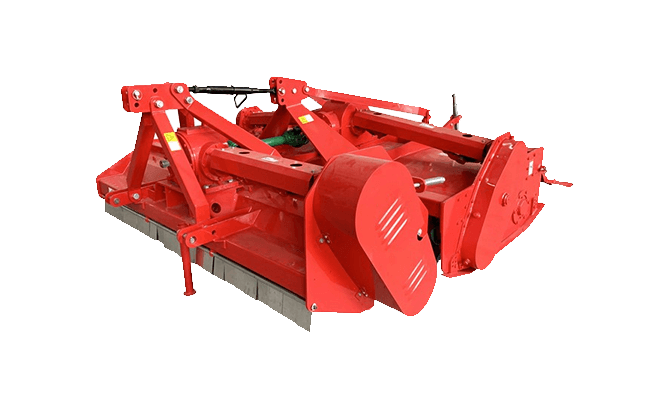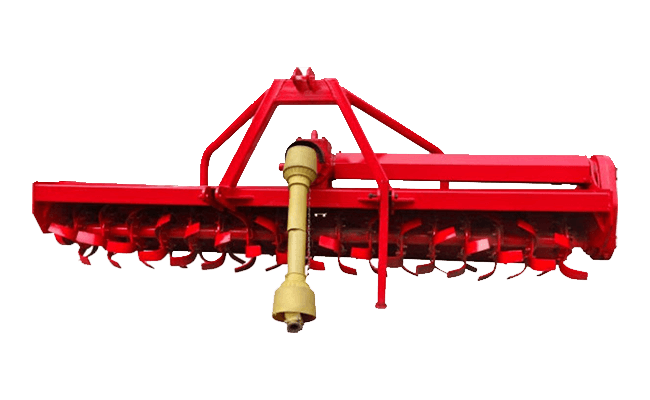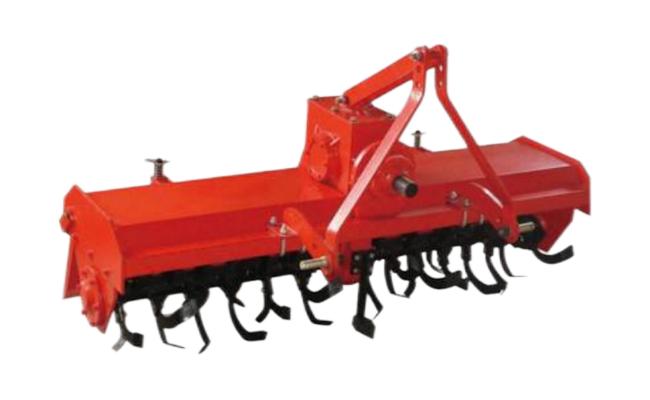Rotavators are essential for soil preparation in agriculture. They use rotating blades to break up and turn over the soil, improving aeration and creating an ideal seedbed. This guide explores the different types of rotavators, their uses, benefits, and maintenance tips, providing valuable insights for farmers, gardeners, and agricultural enthusiasts.
Rotavator, also known as a rotary tiller or rotary hoe, is an agricultural machine used to prepare the soil for planting. It has rotating blades that break up and turn over the soil, improving aeration and creating an ideal seedbed. There are different types of rotavators, including power tillers, rear-tine tillers, front-tine tillers, and tractor-mounted rotavators. You need a rotavator to prepare the soil, control weeds, and mix soil amendments. It saves you time and effort. You need to maintain your rotavator by cleaning it, sharpening the blades, and taking care of the engine.
Discover the Secrets of Rotavators with This Ultimate Guide!
Contents
What is a Rotavator?
Definition:
A rotavator is a heavy-duty agricultural machine designed to till the soil by breaking it up, turning it over, and preparing it for planting. It uses a set of rotating blades or tines that cut through the soil, loosening it to create an optimal seedbed. This process not only aerates the soil but also helps to incorporate organic matter, fertilizers, and other soil amendments. Rotavators are versatile and can be used in various agricultural settings, from small gardens to large commercial farms.
Primary Functions: Rotavators are primarily used for soil preparation, weed control, and mixing soil amendments. They are particularly effective in breaking up compacted soil, which improves water infiltration and root penetration, leading to healthier plant growth.
Key Components:
A rototiller is made up of several key parts that work together to effectively turn soil. Understanding these parts can help you operate and maintain the machine properly.
1. Engine:
What it does: The engine powers the rototiller and gives it the force it needs to spin the blades.
Types: Engines can be gas, diesel, or electric. Gas and diesel engines are more common in bigger, heavy-duty models, while electric engines are usually found in smaller, lightweight models.
2. Blades:
What they do: The blades are the spinning parts that cut into the soil and turn it over. They’re the main part of the rototiller that does the work.
Types: Blades can come in different shapes and designs, like L-shaped, C-shaped, and straight blades. Each type is better for different types of soil and tilling depths.
3. Transmission:
What it does: The transmission transfers power from the engine to the blades. It controls how fast the blades spin and which direction they spin.
Adjust ability: Many rototillers have adjustable transmissions that let you change the speed and power to match different types of soil and tilling needs.
4. Frame:
What it does: The frame holds everything together and gives the rototiller its structure.
Design: The design of the frame can affect how stable and easy to use the machine is. A strong frame is important for heavy-duty tilling.
5. Depth Adjuster:
What it does: The depth adjuster lets you set how deep the blades go into the soil. This ensures you get the same depth of tilling across the whole area you’re working.
Types: Depth adjusters can be manual or automatic. Some models let you adjust the depth more precisely than others.
6. Wheels/Tracks:
What they do: The wheels or tracks let the rototiller move around and stay stable as it moves across the soil.
Types: Smaller rototillers usually have wheels, while bigger ones that attach to tractors might have tracks to give them better traction and stability on uneven ground.
7. Handlebars/Controls:
What they do: The handlebars and controls let you steer and control the rototiller. This includes starting the engine, changing the speed, and setting the depth.
Ergonomics: Well-designed handlebars and controls can make a big difference in how comfortable and in control you feel while using the machine. That can help you avoid getting tired when you’re using it for a long time.
Knowing these parts and what they do can help you choose the right rototiller for you and make sure you use and maintain it correctly. That will help you get the most out of it and make it last as long as possible.

Types of Rotavators
1. Power Tillers
Description and Features: Power tillers are small, motor-driven machines used for small-scale farming and gardening. They are lightweight, easy to handle, and perfect for tight spaces.
Common Uses: Great for tilling small plots, gardens, and allotments.
2. Rear-Tine Tillers
Description and Features: These are larger and more powerful machines with tines located behind the wheels, offering better control and deeper tilling. Rear-tine tillers can handle tough soil conditions and large plots.
Common Uses: Perfect for larger plots and tougher soil conditions.
3. Front-Tine Tillers
Description and Features: These tillers have tines located in front of the wheels, making them more maneuverable but less powerful than rear-tine tillers. They are good for light-duty tilling in smaller areas.
Common Uses: Best for small to medium-sized gardens with softer soil.
4. Tractor-Mounted Rotavators
Description and Features: Heavy-duty rotavators attached to tractors, used for large-scale farming. They can cover large areas quickly and are ideal for commercial farming operations.
Common Uses: Ideal for large fields and commercial farming operations.

Uses and Benefits of Rotavators
Soil Preparation: Rotavators break up and aerate the soil, creating an ideal seedbed for planting. This promotes healthy root growth and improves soil structure.
Weed Control: By cutting and burying weeds, rotavators help control weed growth, reducing the need for chemical herbicides.
Mixing Soil Amendments: Rotavators mix compost, fertilizers, and other soil amendments into the soil, ensuring even distribution and enhancing soil fertility.
Time and Labor Saving: Compared to manual tilling, rotavators save time and effort for soil preparation, making them a must-have tool for farmers and gardeners.
How to Choose the Right Rotavator
Assess Your Needs
Size of the Plot: Determine the size of the area you need to till. Larger areas may require more powerful, tractor-mounted rotavators, while smaller plots can be managed with compact or front-tine tillers.
Soil Type: Consider the soil condition and type. Hard or rocky soil may require a more robust machine like a rear-tine tiller.
Evaluate Power and Size
Engine Power: Choose a rotavator with enough engine power for your needs. More powerful engines can handle tougher soils and larger areas.
Tilling Width and Depth: Make sure the rotavator can till to the desired width and depth. Wider and deeper tilling capabilities are beneficial for larger plots.
Consider Maneuverability and Ease of Use
Weight and Balance: Make sure the machine is easy to handle and maneuver, especially in tight spaces or uneven terrain.
Control Features: Look for features like adjustable handles, easy-start mechanisms, and variable speed controls to make it easier to use.
Budget and Brand Reliability
Cost: Set a budget and find a rotavator that offers the best value. Consider both the initial purchase price and long-term maintenance costs.
Brand and Dealer Support: Choose reputable brands known for quality and reliability. Good dealer support can make a big difference in maintenance and repairs.

Maintaining Your Rotavator
Clean It: Clean your rotavator after each use to prevent soil build-up and rust. Removing dirt and debris from the tines and other parts will help your rotavator last longer.
Take Care of the Blades: Sharpen or replace blades as needed to keep your rotavator working well. Dull blades can reduce performance and damage your rotavator.
Take Care of the Engine: Check and change the oil, check air filters, and replace spark plugs to keep your engine running well.
Store It: Store your rotavator in a dry, covered place to protect it from the elements. Covering your rotavator will also help prevent rust and deterioration.
In Conclusion
Rotavators are great tools for modern farming and gardening because they help you prepare your soil quickly and easily. By understanding the different types and what they’re used for, you can choose the right rotavator for your needs and increase your farming productivity. By taking care of your rotavator and using it properly, you’ll be able to rely on it for years to come.
FAQs
A rotavator is a type of tiller that uses rotating blades to turn the soil. All rotavators are tillers, but not all tillers are rotavators. Tiller is a broader term that includes different types of soil cultivation tools.
It’s not recommended to use a rotavator on very wet soil because it can compact the soil and damage its structure. It’s best to wait until the soil is slightly dry but still workable.
The depth a rotavator can till depends on the model. Most rotavators for home use can till to a depth of 6-8 inches, while heavy-duty, tractor-mounted rotavators can till deeper.
Regular maintenance includes cleaning the machine, sharpening or replacing blades, checking and changing the oil, and checking air filters and spark plugs. Proper storage is also important to extend the life of your rotavator.
Rotavators work well on most types of soil, but their effectiveness can vary. Hard, rocky soils may require more powerful rotavators, while soft, loamy soils can be tilled with less powerful models.

